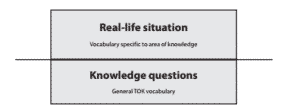So here we are. We’ve looked at real-life situations. We’ve looked at knowledge questions. Now we can get right to the heart of things and figure out how we actually DO the TOK thing: namely the essay and presentation.
If you haven’t yet read the first two installments of this blog series, go have a read of them here before you go any further. This is because what I talked about in my last two posts, real-life situations and knowledge questions, are the cornerstones of what TOK is, and the most important elements of both your TOK presentation and your essay.
For the last time my intrepid IB warriors, let’s TOK this!
What are the TOK assessments?
While this might be blindingly obvious to some of you, I thought it might be good to consider for a second actually what you have to do for TOK.
The assessments for TOK are (in theory) pretty simple. You have one presentation you need to plan and present in class. This is marked by your teacher, and you have to produce a super short plan to hand off. The presentation can be done individually, or in a small group (max 3 is probably a good idea) and is marked out of 10. Ultimately it makes up 33% of your total TOK mark- so not something to be sniffed at!
The second component is your essay. Unlike your presentation (where you decided the topic), the IBO will issue you six prescribed titles and you need to answer one. This makes up a bit more of your total TOK score, still marked out of 10 but worth 67%.
What’s the difference between the two?
I think one of the most crucial things to remember in TOK is that there’s a reason WHY the IBO ask you to do two TOK assignments. While there are similarities, knowing the differences between the two can make a big difference in your grade.
The major difference between the two is how you use real-life situations and knowledge questions. The IBO produce this diagram here to demonstrate the way the two combine, and I find it really helpful when thinking about how to approach a TOK assignment.
IBO
Presentation
When it comes to the presentation, think of it as if you are starting from the top of the above square- with the real-life situation. Because you start here, your presentation will benefit from having a solid real-life situation. If you are struggling with this, check out this article here for some help.
Once you have your real life situation, you need to cross the line in the diagram and talk about knowledge questions. This knowledge questions should come naturally (or rather not be too forced) from your real life situation. So for example, in my TOK presentation, I started by talking about the fact that the US law code had recently had removed the word ‘lunatic’ replaced with ‘mental illness’. From this, I thought about Language and perception, forming the knowledge question ‘How does Language affect our Perception?’
Once you have these two things, you then have to, using the language of TOK analyse the knowledge question to show how it applies to your real life situation. For example, in mine, I spoke about how the word lunatic had certain pejorative connotations. I could, therefore, argue that its use in the legal code could affect sentencing. If you can bring in a few other relevant real-life situations that are great (and can help get you top marks) but this isn’t essential.
Then finally, you end with a brief summary of the major points in your presentation! Easy right…?
The Essay
While you started at the top of that diagram for the presentation, for the essay, you do the opposite. This is partly because you aren’t creating your own knowledge questions (so don’t need the real-life situation as a stimulus) but rather responding to the knowledge questions posed in the IBO’s prescribed titles. For the essay, you want to think of what knowledge questions are being asked in the title. So let’s make use of this year’s titles as an example:
“It is only knowledge produced with difficulty that we truly value. ” To what extent do you agree with this statement?
You are being asked to consider knowledge questions such as:
- what do we mean by the production of knowledge?
- What makes knowledge valuable?
- How do you value knowledge?
Then, you have to move up to the top of the diagram. Think about how you can use real-life situations to analyse and explore these knowledge issues. In the essay, your real-life situations are your evidence, not the meat of your essay.
In the essay, it’s also important to include claims and counterclaims. Making sure you acknowledge both sides of an argument is key. This doesn’t mean you can’t take a point of view, of course. You just have to argue convincingly that your claim is better.
And finally, you have to draw back at the end of your essay to the bottom of the diagram, back into the territory of theoretical knowledge questions. Here you concluded your argument in your essay, using as best you can the language of TOK, and leaving the examiner with your own thoughts on the subject.
Again, easy as pie?
A little extra help?
I hope this series makes TOK a little clearer! If you want a little bit extra help check out our online private tuition for TOK. Our assignment package is perfect for anyone wanting that some support with the trickiness that is TOK!
Watch FREE IB Tips & Tricks Videos!




